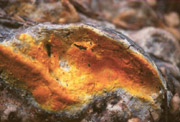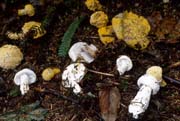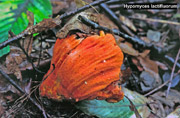
© Zoey Green
The purpose of this key is to present information that will be useful to those seeking to identify Hypomyces species in the field. Specialists use microscopic criteria, and these should be the final arbiter, but it is often possible to come to a reasonable conclusion without resort to the microscope, based on color and a recognizable host.
The most familiar Hypomyces in the Pacific Northwest is Hypomyces lactifluorum, the edible “lobster mushroom”. Named in English for its orange-red color rather than its taste, it fruits as a layer on Russula brevipes mushrooms. As it does so, it interferes with the development of the Russula, so that the gills are not well formed. Hypomyces species form on the surface of mushrooms, partially or completely covering them with a layer of powdery to pimpled tissue, disfiguring the mushroom as they do so.
Many mushrooms are affected by Hypomyces species: Rogerson & Samuels wrote a series of 3 articles describing 10 world species that grow on boletes, 19 species that grow on polypores, and 13 that grow on gilled mushrooms. The most familiar of the other species in the Pacific Northwest are H. chrysospermus, the “bolete eater”, that forms a white to yellow layer on boletes, H. aurantius that forms an orange layer on old polypores, and H. cervinigenus that forms a white to pink layer on Helvella lacunosa.
Hypomyces hyalinus, the “amanita eater” selects Amanita mushrooms as its preferred host. Hypomyces luteovirens is yellow or green as suggested by its Latin name. Hypomyces rosellus is white to “rose”, a bright pinkish red. Hypomyces lateritius has a variety of colors including the brick red suggested by its name. Hypomyces ochraceus is rarely seen in its colored phase.
The sexual form of these fungi (teleomorph) bears ascospores in asci which develop in perithecia. A perithecium is a nearly spherical, ovoid, pear-shaped or beaked (flask-like) body bearing asci in the interior with or without sterile paraphyses, with an opening to the air called an ostiole. The ostiole is generally visible under a hand lens as a small pit or pimple on the surface of the Hypomyces. Other fungi in the Pacific Northwest that have perithecia include Xylaria and Cordyceps.
Most species have an asexual form classified with the mitosporic fungi (anamorphic fungi). In the case of Hypomyces chrysospermus, H. cervinigenus, and H. ochraceus, this form is much more likely to be encountered than the sexual form.
1a Bright red-orange
................................................................................2
1b Different in color (white, yellow, yellowish orange, brick red, reddish black, ochraceous, brown, but not bright orange-red)
................................................................................3
2a Growing on decayed mushrooms (Russula or Lactarius) on the ground
................................................................................Hypomyces lactifluorum
2b Growing on polypores or other mushrooms that grow on wood
................................................................................Hypomyces aurantius
3a (1b) Pinkish brown, growing on Helvella
................................................................................Hypomyces cervinigenus
3b Color different or host different or host unrecognizable
................................................................................4
4a Green or yellow green (growing on Russula or Lactarius)
................................................................................Hypomyces luteovirens
4b Color different or host different or host unrecognizable
................................................................................5
5a White to yellow or rarely red-brown, and growing on recognizable bolete
................................................................................Hypomyces chrysospermus
5b Color different or host different or host unrecognizable
................................................................................6
6a White, pallid when old or tinged with pink, yellow, or brown, growing on recognizable Amanita
................................................................................Hypomyces hyalinus
6b Color different or host different or host unrecognizable
................................................................................7
7a Color white becoming rose-colored or red
................................................................................Hypomyces rosellus
7b Color not becoming rose-colored or red (may be brick red or reddish black)
................................................................................8
8a Color white to lemon yellow when fresh, buff, yellowish orange, tawny, at full maturity becoming ochraceous, brick red and brown or reddish black, growing on gills of Lactarius species
................................................................................Hypomyces lateritius
8b Color different or host different or host unrecognizable
................................................................................9
9a White, growing on Russula or Lactarius, no pits or pimples under hand lens
................................................................................Hypomyces ochraceus, Hypomyces lateritius
9b Color white or different or host different or host unrecognizable
................................................................................microscopic identification needed
| FEATURES The anamorph, the usual form seen, produces a white covering on Helvella species, parasitizing cap and stem tissues, the covering becoming pinkish brown to cocoa brown. DETAILS The anamorph forms a soft, cottony to finely downy, mould-like covering, white becoming pinkish to cream-buff, powdery when old, not changing color in KOH. FRUITING on Helvella species, especially Helvella lacunosa, fairly common. MICROSTRUCTURES Two types of asexual spores are formed: 1) aleuriospores 13.5-17.5 um in diameter including ornamentation, round, spiny, thick-walled, joined to secondary, thin-walled, more or less hemispheric cell, (in deposit the aleuriospores are pinkish buff), 2) conidia 14.0-25.5 x 4.0-5.0 um, cylindric-elliptic, smooth, thin-walled, contents granular or with one to several oil droplets, some centrally septate. Ascospores and perithecia are rare, the ascospores (15)18-22(26) x 2-4(5) um, subfusiform, smooth, at maturity typically 1-septate, the ends pointed, not apiculate. | Hypomyces cervinigenus.jpg) © Fred Stevens (MykoWeb) |
Hypomyces chrysospermus bolete-eater, golden Hypomyces
| FEATURES A three stage mould-like growth on fungi of Boletaceae, the first white, the second yellow, and the third (seldom seen) red-brown and pimpled; covering the cap, stem and tube surfaces of the host and filling the tubes, the host fruitbody becoming decayed (soft and mushy). DETAILS The anamorph is known as Verticillium in the white stage and as Sepedonium chrysospermum in the yellow stage. Formation begins as a white mouldy-looking covering "that attacks and quickly engulfs boletes, then turns bright yellow and powdery", and then finally becomes reddish brown and pimpled (but this final stage rarely seen, only occurring after host is decayed beyond recognition and unpleasant to handle), (Arora). Subiculum is "at first white, usually becoming golden yellow, remaining white or becoming pink, vinaceous to ferruginous"; perithecia "orange-yellow, brick red, red-brown, or rufous brown”, (Rogerson & Samuels). FRUITING grows on members of the Boletaceae, June to September, the anamorph stage common. MICROSTRUCTURES conidia especially in white stage, elliptic, smooth, (Rogerson & Samuels gives conidia as (4)7-13.3(20) x (2.5)3.3-5.5(7) um, Põldmaa et al. as 7-20(25) x 3-10 um, Arora 10-30 x 5-12 um), aleuriospores especially in yellow stage 10-25 um, round, thick-walled, and warted, ascospores in final stage spindle-shaped to lanceolate, verrucose, colorless, usually 1-septate, apiculi acute, longer at upper end than at lower end, (Rogerson & Samuels gives ascospore size as (15)20-25(30) x 4-5(6) um, Põldmaa et al. (13)15-20(25) x 4-6 um, Arora 25-30 x 5-6 um). REMARKS Hypomyces ochraceus is occasionally found on boletes. Hypomyces microspermus Rogerson & Samuels is "the most frequently collected of the boleticolous species in North America" (whereas H. chrysospermus is "the most frequently reported boleticolous species"): H. microspermus, found at least in California (Del Norte Co. in extreme northwest of state), eastern North America, and elsewhere in the world, has ascospores rarely above 15 um in length, not prominently verrucose, varying from equally bicellular to unequally bicellular, whereas those of H. chrysospermus rarely range below 20 um in length, are prominently verrucose, and unequally bicellular, conidia and aleuriospores of H. microspermus averaging somewhat smaller than those of H. chrysospermus but the measurements overlapping, the size of the conidia of H. microspermus given both as 11-14 x 4-5 um and as (5)6.4-11.7(14) x (2.5)2.7-4.5(5) um, size of aleuriospores given as 12-15 um in diameter, (Rogerson & Samuels). | Hypomyces chrysospermus © Steve Trudell |
Hypomyces hyalinus Amanita mold
Hypomyces lactifluorum lobster mushroom
| FEATURES bright orange to reddish color and smoothly pimpled surface, growth on distorted Russula brevipes (and other Russula and Lactarius spp.) whose gills are often reduced to blunt ridges, the growth usually covering the aborted cap and stem as well as gills, anamorph not found in nature. DETAILS "a layer of roughened or pimpled, bright orange to orange-red to purple-red or occasionally yellow-orange tissue which is firm to the touch", (Arora). FRUITING usually on the fruiting bodies of Lactarius and Russula (especially Russula brevipes), predominantly in fall, common, found throughout North America. MICROSTRUCTURES ascospores 30-50 x 4.5-8 um, spindle-shaped or shaped like caraway seeds, colorless, warted, 1-septate, (Arora), ascospores 35-40 x 4.5-7 um, fusiform, prominently verrucose and apiculate, 2-celled, perithecia KOH+ purple, (Rogerson & Samuels), ascospores 35-45 x 5-8 um, fusiform, with one side sometimes flattened, verrucose, verrucae low and confluent, 1-1.5 um high, ends apiculate, spores 1-septate, (Põldmaa et al.). REMARKS Hypomyces macrosporus Seaver (found at least in WA, Mexico, and eastern North America) is distinguishable only by color (subiculum white to buff, perithecia buff to yellowish amber) and negative reaction to KOH and may be merely an ‘albino’ form of this species: orange specimens of H. lactifluorum have been found mixed with specimens that were variously white, white with orange streaks and orange-red with white streaks, but only the reddish streaks of the whitish form became purple in KOH. | Hypomyces lactifluorum © Peter Katsaros |
Hypomyces luteovirens yellow-green Hypomyces
FEATURES profuse, white, cottony, mould-like growth on Lactarius and Russula, or occasionally on boletes, covering spore-bearing surface or usually the whole fruitbody, the fruitbody becoming decayed, often extending over nearby substrate, rarely forming white, buff, or orange teleomorph with pimpled surface (usually on litter, mosses, ground, wood or bark after host destroyed). FRUITING the anamorph (Cladobotrum verticillatum (Link) S.J. Hughes) is common in eastern North America and recorded from Oregon, the teleomorph rare. MICROSTRUCTURES up to three types of "spores": a) conidia 11-24 x 7-12 um, of various shapes, b) chlamydospores (thick-walled cells) about 20 um in diameter with wall 2 um thick, and c) when rare teleomorph is present ascospores that are 32-40 x 5-8 um, 2-celled, verrucose, apiculate.
perithecium (plural perithecia) - a nearly spherical, ovoid, pear-shaped or beaked (flask-like) body bearing asci in the interior, with or without paraphyses, with an opening, characteristic of the pyrenomycetes such as Cordyceps, Xylaria, Claviceps, and Podostroma
subiculum - a net-like, wool-like, or crust-like growth of mycelium under fruiting bodies (in this case supporting the perithecia)
| GENUS AND SPECIES | KEY ENTRY | |
| HYPOMYCES (Fr.) Tul. | ||
| H. aurantius (Pers.: Fr.) Tul. | 2b | Description |
| H. cervinigenus Rogerson & Simms | 3a | Description |
| H. chrysospermus Tul. | 5a | Description |
| H. hyalinus (Schwein.: Fr.) Tul. | 6a | Description |
| H. lactifluorum (Schwein.: Fr.) Tul. | 2a | Description |
| H. lateritius (Fr.: Fr.) Tul. | 8a | Description |
| H. luteovirens (Fr.: Fr.) Tul. | 4a | Description |
| H. macrosporus Seaver | Note | |
| H. microspermus Rogerson & Samuels | Note | |
| H. ochraceus (Pers.: Fr.) Fr. | 9a | Description |
| H. rosellus (Alb. & Schwein.: Fr.) Tul. | 7a | Description |
- END -